Interstrand DNA cross-links induced by alpha,beta-unsaturated aldehydes derived from lipid peroxidation and environmental sources
- PMID: 18500830
- PMCID: PMC2785109
- DOI: 10.1021/ar700246x
Interstrand DNA cross-links induced by alpha,beta-unsaturated aldehydes derived from lipid peroxidation and environmental sources
Abstract
Significant levels of the 1, N(2)-gamma-hydroxypropano-dG adducts of the alpha,beta-unsaturated aldehydes acrolein, crotonaldehyde, and 4-hydroxy-2E-nonenal (HNE) have been identified in human DNA, arising from both exogenous and endogenous exposures. They yield interstrand DNA cross-links between guanines in the neighboring C.G and G.C base pairs located in 5'-CpG-3' sequences, as a result of opening of the 1,N(2)-gamma-hydroxypropano-dG adducts to form reactive aldehydes that are positioned within the minor groove of duplex DNA. Using a combination of chemical, spectroscopic, and computational methods, we have elucidated the chemistry of cross-link formation in duplex DNA. NMR spectroscopy revealed that, at equilibrium, the acrolein and crotonaldehyde cross-links consist primarily of interstrand carbinolamine linkages between the exocyclic amines of the two guanines located in the neighboring C.G and G.C base pairs located in 5'-CpG-3' sequences, that maintain the Watson-Crick hydrogen bonding of the cross-linked base pairs. The ability of crotonaldehyde and HNE to form interstrand cross-links depends upon their common relative stereochemistry at the C6 position of the 1,N(2)-gamma-hydroxypropano-dG adduct. The stereochemistry at this center modulates the orientation of the reactive aldehyde within the minor groove of the double-stranded DNA, either facilitating or hindering the cross-linking reactions; it also affects the stabilities of the resulting diastereoisomeric cross-links. The presence of these cross-links in vivo is anticipated to interfere with DNA replication and transcription, thereby contributing to the etiology of human disease. Reduced derivatives of these cross-links are useful tools for studying their biological processing.
Figures
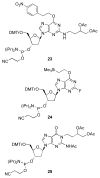

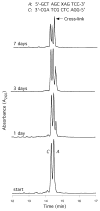





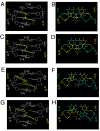
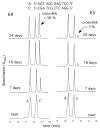
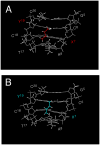

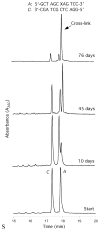
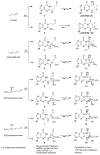
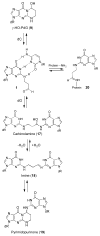

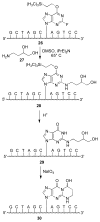

Similar articles
-
Stereospecific formation of interstrand carbinolamine DNA cross-links by crotonaldehyde- and acetaldehyde-derived alpha-CH3-gamma-OH-1,N2-propano-2'-deoxyguanosine adducts in the 5'-CpG-3' sequence.Chem Res Toxicol. 2006 Feb;19(2):195-208. doi: 10.1021/tx050239z. Chem Res Toxicol. 2006. PMID: 16485895 Free PMC article.
-
Chemistry and biology of DNA containing 1,N(2)-deoxyguanosine adducts of the alpha,beta-unsaturated aldehydes acrolein, crotonaldehyde, and 4-hydroxynonenal.Chem Res Toxicol. 2009 May;22(5):759-78. doi: 10.1021/tx9000489. Chem Res Toxicol. 2009. PMID: 19397281 Free PMC article. Review.
-
Spectroscopic characterization of interstrand carbinolamine cross-links formed in the 5'-CpG-3' sequence by the acrolein-derived gamma-OH-1,N2-propano-2'-deoxyguanosine DNA adduct.J Am Chem Soc. 2005 Dec 21;127(50):17686-96. doi: 10.1021/ja053897e. J Am Chem Soc. 2005. PMID: 16351098 Free PMC article.
-
Rearrangement of the (6S,8R,11S) and (6R,8S,11R) exocyclic 1,N2-deoxyguanosine adducts of trans-4-hydroxynonenal to N2-deoxyguanosine cyclic hemiacetal adducts when placed complementary to cytosine in duplex DNA.J Am Chem Soc. 2008 Aug 20;130(33):10898-906. doi: 10.1021/ja801824b. Epub 2008 Jul 29. J Am Chem Soc. 2008. PMID: 18661996 Free PMC article.
-
DNA cross-link induced by trans-4-hydroxynonenal.Environ Mol Mutagen. 2010 Jul;51(6):625-34. doi: 10.1002/em.20599. Environ Mol Mutagen. 2010. PMID: 20577992 Free PMC article. Review.
Cited by
-
Synthesis of cross-linked DNA containing oxidized abasic site analogues.J Org Chem. 2014 Jul 3;79(13):5948-57. doi: 10.1021/jo500944g. Epub 2014 Jun 20. J Org Chem. 2014. PMID: 24949656 Free PMC article.
-
Cellular Repair of DNA-DNA Cross-Links Induced by 1,2,3,4-Diepoxybutane.Int J Mol Sci. 2017 May 18;18(5):1086. doi: 10.3390/ijms18051086. Int J Mol Sci. 2017. PMID: 28524082 Free PMC article.
-
Atorvastatin Can Modulate DNA Damage Repair in Endothelial Cells Exposed to Mitomycin C.Int J Mol Sci. 2023 Apr 5;24(7):6783. doi: 10.3390/ijms24076783. Int J Mol Sci. 2023. PMID: 37047754 Free PMC article.
-
Occurrence, Biological Consequences, and Human Health Relevance of Oxidative Stress-Induced DNA Damage.Chem Res Toxicol. 2016 Dec 19;29(12):2008-2039. doi: 10.1021/acs.chemrestox.6b00265. Epub 2016 Nov 7. Chem Res Toxicol. 2016. PMID: 27989142 Free PMC article. Review.
-
DNA repair mechanisms in cancer development and therapy.Front Genet. 2015 Apr 23;6:157. doi: 10.3389/fgene.2015.00157. eCollection 2015. Front Genet. 2015. PMID: 25954303 Free PMC article.
References
-
- Burcham PC. Genotoxic lipid peroxidation products: Their DNA damaging properties and role in formation of endogenous DNA adducts. Mutagenesis. 1998;13:287–305. - PubMed
-
- Chung FL, Nath RG, Nagao M, Nishikawa A, Zhou GD, Randerath K. Endogenous formation and significance of 1,N2-propanodeoxyguanosine adducts. Mutat Res. 1999;424:71–81. - PubMed
-
- Chung FL, Zhang L, Ocando JE, Nath RG. Role of 1,N2-propanodeoxyguanosine adducts as endogenous DNA lesions in rodents and humans. IARC Sci Pub. 1999;150:45–54. - PubMed
-
- Nair U, Bartsch H, Nair J. Lipid peroxidation-induced DNA damage in cancer-prone inflammatory diseases: A review of published adduct types and levels in humans. Free Radic Biol Med. 2007;43:1109–1120. - PubMed
-
- Hecht SS, Upadhyaya P, Wang M. Reactions of α-acetoxy-N-nitrosopyrrolidine and crotonaldehyde with DNA. IARC Sci Pub. 1999;150:147–154. - PubMed
Publication types
MeSH terms
Substances
Grants and funding
LinkOut - more resources
Full Text Sources
Other Literature Sources

